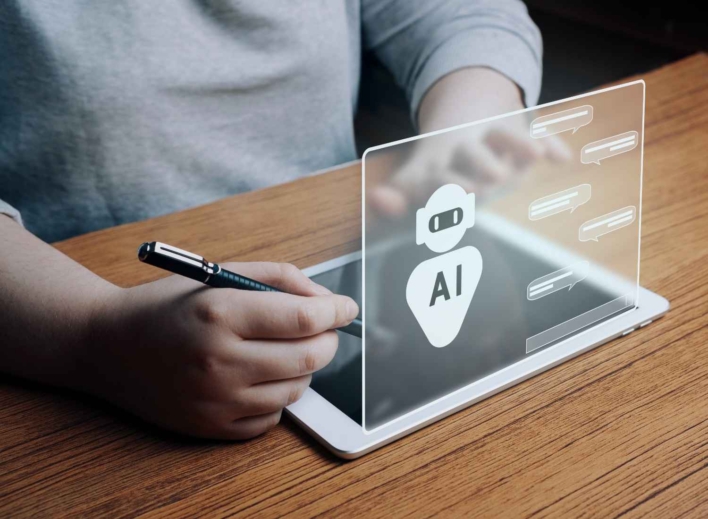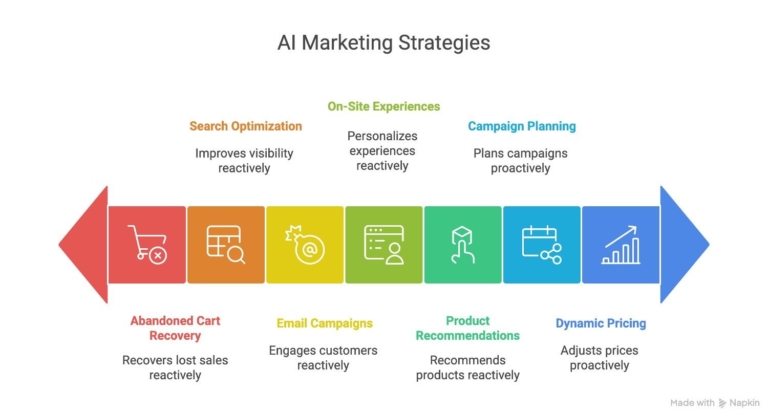Greetings! I'm Aneesh Sreedharan, CEO of 2Hats Logic Solutions. At 2Hats Logic Solutions, we are dedicated to providing technical expertise and resolving your concerns in the world of technology. Our blog page serves as a resource where we share insights and experiences, offering valuable perspectives on your queries.

Black Friday is no longer a test of who can slash prices the deepest. It’s a test of who can deliver the right offer to the right shopper at the right moment. As an e-commerce owner, you’re juggling thin margins, exploding ad costs, inventory constraints, and customers who expect personalized experiences. That’s where AI earns its keep: it turns customer signals (browsing behavior, past purchases, engagement times) into timely, personalized actions that increase conversion and protect margin.
In this post, you’ll find practical, ready-to-run ideas for using AI across email, on-site experiences, pricing, recommendations, and cart recovery. But there are tactics you can apply to this Black Friday season.
Implement the best strategies to make your customers stay and buy more.

Personalize Product Recommendations
Every shopper wants to feel like your store “gets” them. AI makes that possible at scale. Traditional recommendation engines rely on simple rules (“customers who bought X also bought Y”), but AI-powered systems go deeper. They analyze browsing patterns, past purchases, and even real-time behavior to predict what each shopper is most likely to buy next.
How it helps you this Black Friday:
When traffic surges, personalized product suggestions keep your visitors engaged longer and increase average order value. For example, if someone buys a winter jacket, AI can automatically recommend matching gloves or scarves. This can be done without manual setup or tagging every product.
Quick Implementation Tip:
If your store runs on platforms like Shopware, Shopify, or Magento, integrate an AI-driven recommendation tool such as Nosto, Dynamic Yield, or Clerk.io. These solutions plug into your catalog and deliver instant personalization without needing a full AI infrastructure.
Pro Insight:
Don’t limit recommendations to product pages. Add them to:
- The homepage (returning visitors see new picks based on prior sessions)
- Cart pages (“You might also like…”)
- Post-purchase emails (“Pair your recent purchase with…”)
Personalized recommendations not only help your customers discover more but also make your store feel curated. This is something that’s crucial when every competitor is offering discounts.
Dynamic Pricing and Real-Time Offers
Black Friday shoppers are deal hunters, but not all of them need the same offer to convert. That’s where AI-driven dynamic pricing comes in. Instead of applying flat discounts across your store, AI analyzes demand, inventory levels, customer intent, and purchase history to create personalized price points and real-time offers.
Why it matters:
Flat discounts might bring traffic, but they also cut into profits. AI helps you stay competitive without underselling. For example, if a returning customer often buys from a specific brand, the system can automatically trigger a small exclusive discount on that brand. This is enough to close the sale without hurting margins.
Quick Implementation Tip:
You don’t need a custom-built AI system. Many e-commerce platforms now integrate with AI-powered pricing tools like Prisync, Omnia Retail, or Intelligems. These tools monitor competitor prices, automate discount logic, and adjust pricing dynamically during peak hours.
Pro Insight: Combine dynamic pricing with behavioral segmentation. Offer loyal customers exclusive early access, reward high-value shoppers with personalized bundles, and trigger small incentives for first-time buyers who show exit intent.
AI-Powered Email and SMS Campaigns
Your Black Friday emails are competing with hundreds of others in your customers’ inboxes all shouting “Biggest Sale Ever!” What makes yours stand out isn’t louder text or flashier graphics, but personalization powered by AI.
AI can analyze customer behavior. This can be done from browsing habits to purchase frequency and engagement times. This helps to craft messages that feel tailor-made for each recipient. Instead of blasting one generic email to your entire list, AI segments your audience into smaller, smarter groups and sends messages that resonate.
Why it matters:
Customers are 80% more likely to purchase from brands that offer personalized experiences. During Black Friday, when attention spans are short, personalized content can make or break your campaign’s performance.
How it works:
- Smart segmentation: AI tools like Klaviyo, ActiveCampaign, or HubSpot AI automatically cluster users by interests, purchase history, and likelihood to buy.
- Dynamic content: Personalize email subject lines, product images, and even discount amounts based on the user’s previous activity.
- Send-time optimization: Let AI decide when to send each message — so it lands when a customer is most active.
- Predictive follow-ups: If a user clicks but doesn’t buy, the system can send a follow-up SMS or email highlighting similar items or a limited-time offer.
Example:
Instead of sending “Black Friday Sale – 40% Off Everything,” AI allows you to say:
“Hey Anna, your favorite skincare brand is now 25% off. But hurry — this offer ends tonight!”
That level of personalization feels less like marketing and more like a helpful reminder — and it’s proven to drive higher open and conversion rates.
Pro Insight: Use AI to blend urgency and relevance. Don’t just say “Sale ends soon.” Say “The sneakers you viewed twice are almost sold out.” It connects timing with intent, the sweet spot where most conversions happen.
Personalized On-Site Experiences
Your website is the digital storefront and on Black Friday, it needs to adapt as quickly as your shoppers do. Static banners and one-size-fits-all layouts simply can’t compete anymore. AI enables dynamic, personalized on-site experiences that change based on who’s visiting, what they’ve browsed, and where they are in their buying journey.
Why it matters:
When traffic spikes during Black Friday, even small friction points can mean lost sales. Personalized on-site elements guide shoppers smoothly from interest to purchase, keeping them engaged and reducing bounce rates.
How AI Personalizes the Experience:
- Dynamic Homepage Content: Returning visitors see new arrivals or restocks of items they’ve viewed before, while new visitors are shown bestsellers or trending offers.
- Smart Banners & Pop-ups: Instead of generic promotions, display time-sensitive or interest-based banners. Example: “Welcome back! The laptop you viewed is now 15% off for the next 3 hours.”
- AI Chatbots & Product Finders: AI assistants can ask a few quick questions (“Looking for gifts under ₹2000?”) and instantly recommend products that fit, mimicking the experience of an in-store salesperson.
- Behavior-Based CTAs: A first-time visitor might see “Explore Our Black Friday Deals,” while a returning customer might get “Pick up where you left off.”
Tools You Can Try:
Platforms like Nosto, Adobe Sensei, or Shopware’s AI Assistant can help personalize content blocks, product grids, and recommendations without heavy development work.
Pro Insight: Combine personalization with scarcity tactics. For instance, when AI detects a repeat visitor viewing a popular product, trigger a subtle message like “Only 3 left in stock.” It adds urgency, but in a relevant, data-backed way.
Personalized on-site experiences aren’t just about aesthetics; they’re about making every second count for every visitor during the busiest shopping weekend of the year.
AI-Powered Abandoned Cart Recovery
Cart abandonment is one of the biggest challenges for e-commerce stores and during Black Friday, when visitors spike, even a small recovery rate can mean thousands in extra revenue. AI takes cart recovery far beyond simple reminder emails by understanding why each shopper abandoned and responding with the right message, timing, and offer.
Why it matters:
Not every shopper leaves for the same reason. Some compare prices, others hesitate about shipping costs, and a few simply get distracted. Traditional recovery emails treat all these cases alike. AI identifies patterns behind each behavior and tailors recovery efforts accordingly turning “lost” carts into conversions.
How AI Improves Cart Recovery:
- Behavior Prediction: AI systems track user activity to predict intent. This is done by distinguishing between casual browsers and serious buyers.
- Personalized Follow-Ups: Instead of “You left something in your cart,” AI can send a message like, “The headphones you viewed twice are back in stock and shipping is free today.”
- Smart Timing: AI determines when a user is most likely to open or click, ensuring recovery emails and SMS hit at the right moment.
- Dynamic Incentives: Offer discounts strategically example, only to users with high purchase intent, not everyone who abandons a cart.
Example in Action:
A shopper adds a smartwatch to the cart but doesn’t complete checkout. After a few hours, they receive:
“Still thinking about your new smartwatch? It’s now available with free express delivery grab yours before the deal ends!”
If they open the message but still don’t buy, AI can trigger a chatbot on their next visit offering a small, time-limited discount.
Tools to Explore:
Solutions like CartStack, Rejoiner, or Shopware Flow Builder with AI add-ons can automate this process with minimal setup.
Pro Insight: Use AI to balance urgency and empathy. Sometimes a small nudge like “Need help completing your order?” performs better than aggressive discount pushes. The key is personalization rooted in understanding, not pressure.
Predictive Analytics for Campaign Planning
Black Friday success doesn’t start on the day itself. It starts with smart planning. Predictive analytics powered by AI helps e-commerce owners prepare by transforming data into foresight. Instead of relying on guesswork or last year’s results, AI can forecast demand, identify customer trends, and optimize inventory and marketing budgets for maximum returns.
Why it matters:
During Black Friday, decisions must be fast and data-driven. Predictive analytics gives you a clear picture of what products will perform best, which audience segments are most likely to convert, and when to scale or pause campaigns.
How It Works:
- Demand Forecasting: AI models analyze sales history, browsing data, and seasonal trends to predict which products will surge in demand. This helps you stock up intelligently avoiding both overstocking and missed opportunities.
- Customer Behavior Prediction: AI identifies high-value customers likely to purchase again, helping you target them with early-access offers or exclusive bundles.
- Marketing Optimization: Predictive models assess which channels (email, paid ads, social) yield the best ROI, allowing you to allocate your ad spend effectively.
- Return Risk Estimation: AI can even predict which items are likely to be returned more often, helping you design better offers or adjust product descriptions.
Example:
An online fashion store uses predictive analytics before Black Friday and discovers that demand for winter accessories spikes 40% earlier than expected. By promoting scarves and gloves in pre-sale campaigns, they capture early-bird shoppers and boost conversions before competitors even launch their deals.
Tools to Explore:
Platforms like Google Cloud AI, Shopware’s AI Suite, and Adobe Analytics offer predictive analytics modules tailored for e-commerce. These integrate with your store data and visualize insights you can act on instantly.
Pro Insight: Start tracking now, even if Black Friday is days away. The more data your AI has to learn from, the more accurate its predictions become for next season.
Weekly Insights
Get our best content delivered to your inbox every week.
Voice and Visual Search Optimization
Shoppers today are searching with their voices and cameras, not just keyboards. During Black Friday, when customers want quick answers and instant results, optimizing your store for AI-driven voice and visual search can significantly improve discoverability and conversions.
Why it matters:
Modern consumers expect speed and convenience. Voice assistants like Alexa, Siri, and Google Assistant are now part of everyday shopping habits. While visual search tools help users find products simply by uploading a photo. AI bridges both experiences, helping customers get what they want faster, with fewer clicks.
How It Works:
- Voice Search Optimization: AI interprets conversational queries (like “show me budget-friendly gaming laptops under $1000”) and surfaces relevant results. Optimizing product titles, descriptions, and metadata for natural language helps your store appear in these voice-based results.
- Visual Search: AI-powered image recognition lets users upload or scan a product image and instantly find similar items from your catalog. This is particularly powerful for fashion, furniture, and lifestyle brands.
- Smart Suggestions: When a user searches for “red sneakers,” AI can suggest related styles, sizes, and accessories based on that image or phrase.
Example:
A shopper sees a jacket on social media, uploads the photo on your site’s visual search bar, and instantly finds matching or similar products in your inventory. And the product is available with a Black Friday discount. One seamless experience, powered by AI.
Tools to Explore:
- Visual AI Platforms: Syte, Visenze, and Google Cloud Vision AI integrate easily with eCommerce systems.
- Voice Optimization Tools: Implement structured data and schema markup to help your products rank in voice results.
AI-powered search doesn’t just help customers find products. It helps them find exactly what they want, faster, which is the ultimate edge during Black Friday’s shopping frenzy.
Conclusion
Black Friday success is no longer just about offering the biggest discounts. It’s about creating personal, intelligent shopping experiences that build loyalty long after the sale ends. AI makes that possible.
For e-commerce store owners, AI is the competitive advantage that defines which stores thrive during the holiday rush and which ones get lost in the noise.
If you haven’t yet implemented AI personalization in your store, this is the perfect time to start. Even small, well-placed AI tools can transform how your customers shop and how your business performs.

Related Articles








